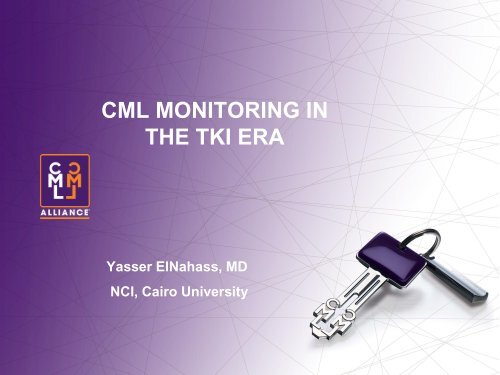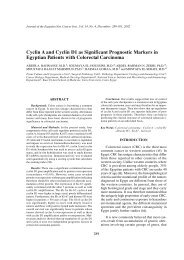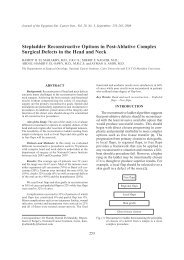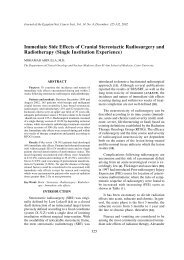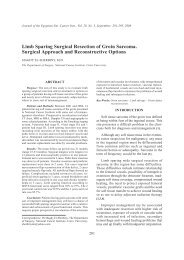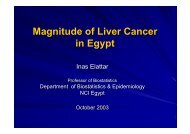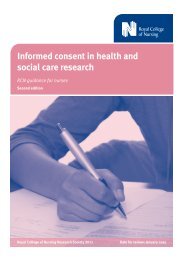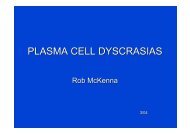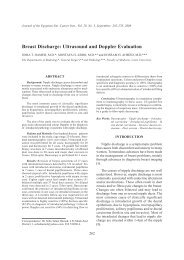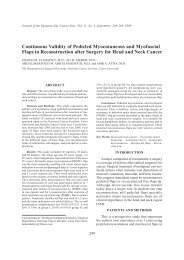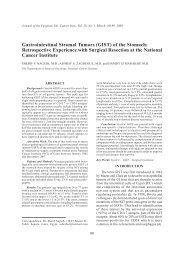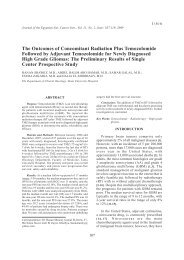Full Text pdf - NCI
Full Text pdf - NCI
Full Text pdf - NCI
You also want an ePaper? Increase the reach of your titles
YUMPU automatically turns print PDFs into web optimized ePapers that Google loves.
CML MONITORING INTHE TKI ERAYasser ElNahass, MD<strong>NCI</strong>, Cairo University
DisclaimerThis presentation reflects only my personal opinion, not thatof my employer or faculty, for the purposes of independentscientific discussion. The data I present and my views mayrelate to doses or indications outside of those recommendedin medicinal product SmPCs. Please refer to prescribinginformation and SmPCs in your country of practice for moreinformation.2
2008 WHO CLASSIFICATION OF MPNsPhiladelphia chromosome Positive:• CML3Philadelphia chromosome Negative:• Polycythemia vera (PRV)• Essential thrombocythemia (ET)• Primary myelofibrosis (PMF)• Chronic neutrophilic leukemia• Chronic eosinophilic leukemia (CEL), not otherwise categorized• Hypereosinophilic syndrome (HES)• Mast cell disease• MPNs, unclassifiable
Molecular Etiology of Ph+ CML BCR-ABLStructure and FunctionPh+ CML Ph+ chromosome Processes affectedkaryotypeby Bcr-Abl4
CML Phases5Chronic-phase CML (WHO):1.
CML: investigations at diagnosisMetaphase6Von Bunhof and Buyster, EHA, (2007)
CML: Findings in PBMyelocyteBasophilPromyelocyteBasophilMyeloblast7
CML: BM MorphologyIncreased granulocytopoiesis(Neutrophilic granulocytes,basophils, and eosinophils)Increased numbers of megakaryocytes,including many with round nucleiand mature cytoplasm8All cells are negative forleukocyte alkaline phosphataseExtremely high cellular BMB withpaucity of fat cells
Cytogenetic analysisKaryotype:Standard technique for diagnosisSensitivity : Low 10 -2Used to evaluate remission samples.Advantages: Can detect CCA in Ph +ve cells.Drawbacks: 1.Requierement for dividing cells (BM sample).2. High failure rate.We count 20 metaphase cells : 46, XX, t(9; 22) (q34;q11) [19]9
10Philadelphia chromosome
11Philadelphia chromosome
12CCA in Ph positive cell= +19, +20
13Iso (17)
14CCA in Ph positive cell= double Ph’
Fluorescent In Situ Hybridization(FISH)Sensitivity: higher 10 -3Co hybridization of BCR and ABl probes.Advantages:1. Failure rate is lower than standard karyotyping in post treatmentmarrows2. Applied to interphase nuclei on PB.3. Does not require dividing cells.nuc ish 9q34 (abl x 2), 22q11 (bcr x 2) [95/100]15
16FISH BCR-ABL
17Locations of the breakpoints in theABL and BCR genes
Mechanism of Action of ImatinibBCR-ABL oncoproteinwith a molecule of ATPin the kinase pocket.Substrate is phosphorylated on a tyrosineresidue and, in its phosphorylated state, canthen interact with other downstreameffector molecules.19When IM occupies the kinase pocket ,the action of ATP is inhibited, and thesubstrate cannot be phosphorylatedGoldman JM, Melo JV. N Engl J Med. (2001) 344:1084-1086.
20RQ-PCR amplification assays:measures BCR-ABL transcripts
RQ-PCR technologyTaqMan Uses a Dual-Labeled ProbeReporter dyeQuencher dyePolymerization5’3’5’Strand Displacement5’ 3’5’RRQQR= ReporterQ= Quencher5’3’5’5’3’5’Cleavage5’ 3’5’RQ5’3’5’Polymerization Completed5’3’RQ5’215’3’5’
Use of a conversion factor to convert BCR-ABL values in a givenlaboratory to International Scale (IS)RNARefp210ABLRelative Conc(p210/ABLratio)RNA Ref CalculatedTiterNAD Ref.TiterLab ConversionFactor (CF)Mean ConcMean ConcRNA 1a 10870.71 48609.39 0.2236RNA 1 20.55% 15.9063% CF 1 0.77385768RNA 1b 6606.61 35243.32 0.1875RNA 2a 1468.54 35115.33 0.0418RNA 2 3.76% 1.5734% CF 2 0.41802665RNA 2b 1580.55 47241.23 0.0335RNA 3a 124.68 39678.00 0.0031RNA 3 0.250% 0.1816% CF 3 0.72776072RNA 3b 84.41 45666.08 0.0018RNA 4a 13.18 32065.47 0.0004RNA 4 0.032% 0.0212% CF 4 0.6542905RNA 4b 6.03 25429.05 0.000222Lab Conversion Factor 0.691
Goals of TKI therapy in CMLCURRENTComplete Hematologic ResponseCytogenetic ResponseComplete Cytogenetic ResponseMolecular ResponseComplete Molecular Response23Cure?
ELN 2009: Definitions of ResponseResponse by typeHematologicComplete Hematologic Response (CHR)CytogeneticComplete (CCgR)Partial (PCgR)Minor (mCgR)Minimal (minCgR)None (noCgr)Definition• WBC 10 4 )24Baccarani et al, J Clin Oncol., 2009
ELN 2009: Monitoring of ResponseResponseHematologicCytogenetic bychromosomebanding analysis ofmarrowMonitoring• At diagnosis, then• Every 15 days until CHR has been achieved and confirmed, then• At least every 3 months or as required• At diagnosis,• At 3 months• At 6 months; then• Every 6 months until a CCgR has been achieved and confirmed, then• Every 12 months if regular molecular monitoring cannot be assured• Always for occurrences of treatment failure (primary or secondaryresistance), and for occurrences of unexplained anemia, leukopenia, orthrombocytopeniaMolecular byRT-Q-PCR• Every 3 months until MMolR has been achieved and confirmed, then• At least every 6 monthsMolecular bymutational analysis• In occurrences of suboptimal response or failure• Always required before changing to other TKIs or other therapies25Baccarani et al, J Clin Oncol., 2009
28The BCR-ABL transcript percentparallels the number of leukemic cells
Imatinib Front line therapy in CML Patients:Response MilestonesOptimalSuboptimalFailureWarningBaselineNANANA• High risk;• CCA/Ph+3• CHR and• At least minor CgR(Ph+ < 65%)No CgR> 95%)(Ph+Less than CHRNA6At least PCgR 35%)No CgR> 95%)(Ph+NA12CCgRPCgR1% to 35%)(Ph+Less than PCgR(Ph+ >35%)Less thanMMolR18MMRLess than MMRLess than CCgRNAAny timeduringtreatmentStable or improvingMMR• Loss of MMolR• Mutations 1• Loss of CHR• Loss of CCgR• Mutations 2• CCA/Ph+• Increase intranscriptlevels• CCA/Ph-291. Mutations still sensitive to imatinib 2. Mutations poorly sensitive to imatinibCCA; clonal chromosomal abnormalitiesBaccarani et al, J Clin Oncol., 2009
RESISTANCE TO IMATINIB1ry Resistance (Refractoriness):No CHR by 3 Mo ,No CCyR by 12 Mo orNo MMR @ 18 months, Bcr-Abl transcript rise or plateau2ry Resistance (acquired) :loss of an established Hematologic response (or progression to AP or ABC),loss of Cytogenetic response (increase of 30% or more Ph +ve BM metapahases @ 3 m’ intervals)or acquisition of CCA in Ph+ve cells orloss of Molecular response (rise of 1 log Bcr-Abl/Abl ratio % on serial testing)30consider : Abl Kinase domain mutations Study
ELN 2009: Prognostic factorsImatinib first lineAt any time: Predictors of lower PFS and OS:• CCA/Ph+ (chromosomal progression): Failure• Any loss of CHR or CCgR predicted shorter PFS/OS• The prognostic significance of loss of MMR iscontroversial; however, any rise in transcript levelswarrants closer monitoring.31Baccarani et al, J Clin Oncol., 2009
33Suboptimal response defined by RQ-PCR
Therapeutic choices in patients with Ph- Positive CML: SCT or TKI?Hossam K. Mahmoud 1 , A. El-Haddad 1 , O. Fahmy 2 , M. Abdel-Mooti 1 , R. Abdel-Fattah 1,Y. El-Nahass 3 , M. El-Emary 4 , A. Sobhy 4 , G. Fathy 4 , A.Sultan 4 .CensoredDeath/Relapse100Flu/Bu (August 2006 - November 2008)N.=34CensoredDeath/Relapse100Bu/Cy (Spaced & Fractionated)(August 2005 - April 2007)N.=46TKI80< 1 year 76%> 1 year 66%80< 1 year 66%%60%60> 1 year 53%P = 0.24040202006 12 18 24 30Number of Months06 12 18 24 30 36Number of monthsHowever this line of treatment requires tremendous resources and it becomes increasingly difficult forhematologists practicing in the developing world especially in Egypt where resources are limited toreconcile the difference between what is possible and what is available.34PACC 2009 A10
13th Congress of the European Hematology Association, June 12-15, 2008Haematologica 2008: 93(s1):222 Abs.0548SEQUENTIAL MOLECULAR MONITORING OF PATIENTS WITH CHRONIC PHASE MYELOGENOUS LEUKEMIADURING IMATINIB MESYLATE TREATMENT. CLINICAL SIGNIFICANCE AND PREDICTIVE VALUEH. Kamel 1 , Y.El-Nahas 1 , M. Abdel Moaty 1 , R. Abdel Fattah 1 , M. El Emary 2 , W. ElMetnawy 31National Cancer Institute, Cairo University, Egypt; 2Nasser Institute , Ministry of Health , 3Medical School, Cairo University, EgyptBackground and Purpose. To determine the value of regular sequential determinations of bcr-abl transcripts by RT Q-PCR in identifying thepattern of long term response to IM in Egyptian patients with chronic phase CML, correlation with hematologic andcytogenetic response.Patients and Methods. Seventy five Egyptian patients with CP CML , treated with a daily oral dose of IM 400 or 600mg were followed for amedian follow up (FU) period of 20.6 months ( range 6-43 months) . RT Q-PCR was performed at regular intervals every 3 months during thewhole FU period ,cytogenetic analysis by conventional karyotyping or FISH was performed every 3 or 6 months.Results. The median Bcr-Abl/Abl ratio before the start of therapy was 12.3 (range: 0.23-20). Analyses of the results showed that 70 patients(93%) had hematologic response, 53 patients ( 70%) achieved partial and complete cytogenetic response (PCR &CCR) by 12 months. Amongthese 53 patients only 36 patients (48%) who achieved major molecular response (3 log reduction from initial Bcr-Abl/Abl ratio), and Bcr-Abltranscripts became undetectable in 19 (25%) of them through 24 months follow up period with more than 4.5 log reduction from initial Bcr-Abl/Ablratio upon consecutive measurements. Four patients (5%) attained major molecular response (3 log reduction ) after 18 months and wereconsidered late responders. A suboptimal response was observed in 13 patients (17%) who maintained 2 log reduction with partial cytogeneticresponse along 18-43 months follow up, and five of them demonstrated a reincrease of Bcr-Abl transcripts as detected by Q-RT PCR .Only oneof the 5 patient could gain major molecular response upon increasing the dose of IM to 600 mg. Primary resistance was observed in 18 (24%) ofthe 75 patients who have not demonstrated any molecular or cytogenetic response since the start of treatment. Study of the Abl kinasemutations. T 315 I, F 311 L , E 255 K and the M 351 T was performed by ASO PCR in 12 patients. The M 351 T mutation was found in 3 casesout of 7 with primary resistance, the same mutation was also found in one out of 3 patients with suboptimal response. One patient relapsedduring treatment did not have any of the studied mutations but had clonal evolution with acquisition of a new chromosomal abnormality.Conclusions. Molecular monitoring of Bcr-Abl transcripts during IM treatment of patients with CP CML is a reliable predictive method of thecourse 35 of the disease. The inferior response to IM in this sample of Egyptian population may be either attributed to the limited sample size ormore likely, to differences in biology from the western population.
Correlation between 2 log reductions in Bcr-Abl transcripts at 6 monthsand cytogenetic and molecular responses:2 log reductions at 6monthsCCyR at 12 months MMR at 12 months MMR at 18 monthsYes (n: 59) 49 (83%) 42 (71%) 50 (84%)No (n: 34) 5 (15%) 5 (15%) 9 (26%)p
PFS100= 2 log reductions (n=59)
Progression-free survival a (%)IRIS Study: Risk of Progression Associated With MMR onImatinib Frontline at 6 Months10080604020BCR-ABL ratio (IS) at 6 months n PFS, a %≤0.1% 86 96%>0.1% – ≤1.0% 89 98%>1.0 – ≤10% 43 95%>10% 38 76%P=NSP=NS00 12 24 36 48 60 72 84 96Months since start of treatment38IRIS 7-year follow-up: A multicenter, open-label, phase III randomized study of imatinib (n=553) versus interferonalfa plus cytarabine (n=553) in early CP CML patients.aProgression to AP or BP CML.AP=accelerated phase; BP=blast phase; MMR=major molecular response; NS=not significant;PFS=progression-free survival.Hughes TP et al. Blood. 2010;116:3758–3765.
BCR-ABL kinase domain mutations1. Drug binding mutations:directly impair drug binding: T315I/ F317L/F359V.2. P loop (ATP binding loop) mutations:aa 244-255; normally accommodates phosphate group of ATP; mutations do notallow P loop to adopt IM induced conformation : Y253H, Q252H, E255K.3. C loop (Catalytic domain) mutations:aa 350-363; stabilize the auto inhibited conformation of BCR-ABL: M351.4. A loop (Activation loop) mutations:aa 381-402; Regulates kinase activity; mutations prevent the kinase from adoptingits inactive conformation39
ABL Kinase domain mutations40BCR-ABL characterized mutants associated with clinical resistance to imatinib.(Kantarjian et al., 2006).
Mutations critical for 2 nd generation TKIsMutations with nosensitivity to dasatinibornilotinibT315IMutations less sensitiveto dasatinibF317L/VV299LMutations less sensitive tonilotinibY253HE255K/VF359V41O’Hare et al., Blood (2008)
ABL KINASE DOMAIN MUTATIONS IN IMATINIB-TREATEDEGYPTIAN PATIENTS with CHRONIC MYELOID LEUKEMIAYasser H. ElNahass 1 , Hossam K. Mahmoud 2 , Fahmy T. Ali 3, Mohamed R. Mohamed 3 Mahmoud M. Said 3Mohamad Abdel Moaty Samra 2 , Mohamed A.M. Ali 3 , Amir SALEM 4 and Wafaa H. ElMetnawy 5Journal of Leukemia, 2013P = 0.003P = 0.011P = 0.01742
ABL KINASE DOMAIN MUTATIONS IN IMATINIB-TREATEDEGYPTIAN PATIENTS with CHRONIC MYELOID LEUKEMIAYasser H. ElNahass 1 , Hossam K. Mahmoud 2 , Fahmy T. Ali3, Mohamed R. Mohamed 3 Mahmoud M. Said 3Mohamad Abdel Moaty Samra2, Mohamed A.M. Ali3, Amir Salem 4 and Wafaa H. ElMetnawy 5Journal of Leukemia, 201343
Delayed Achievement of Response Increases Risk ofProgression• During the first 12 months of imatinib treatment for CP CML, patientswho have failed to achieve a CCyR have– A decreasing probability of ever achieving a CCyR on imatinib– An increasing risk of loss of response, disease progression, or deathMonths ontreatmentPatients not inCCyR (n)Eventual outcome in patientsnot in CCyR at the specified time (%)CCyR MMR Event3 109 75 62 236 47 57 43 3412 26 42 31 38In patients who failed to achieve a CCyR by 12 months, the probability ofeventually achieving a CCyR was only 42%, which was similar to theprobability of loss of response, disease progression, or death (38%)44CCyR=complete cytogenetic response; CP=chronic phase; MMR=major molecular response.Quintás-Cardama A et al. Blood. 2009;113:6315–6321.
Faster and deeper molecular responses to IM predictimproved PFS and OS in the first-line setting 1-3At 3 months on BCR-ABL inhibitor therapy, BCR-ABL ≤10%has been associated with increased probability of:•Better 8-year OS: 93.3% vs 56.9% (P
Predictive Value of Pretreatment BCR-ABL IS Transcript level and BCR-ABL IS ≤ 10% at 3months on Response to Imatinib Therapy in Egyptian Patients with Chronic Phase ChronicMyeloid Leukemia (CPCML)Wafaa H. El Metnawy, Mervat M. Mattar*, Yasser H. ElNahass**, Mohamed Abdelmooty Samra***, Hala M.Abdelhamid*, Raafat M AbdlFattah*** and Ahmad R. Hamed****International Journal of Biomedical Science, 2013MMR at 18 monthsNoYes2 19BCR- ABL at 3 months10%9.5% 90.5%25 973.5% 26.5%46
Predictive Value of Pretreatment BCR-ABL IS Transcript level and BCR-ABL IS≤ 10% at 3 months on Response to Imatinib Therapy in Egyptian Patientswith Chronic Phase Chronic Myeloid Leukemia (CPCML)Wafaa H. El Metnawy, Mervat M. Mattar*, Yasser H. ElNahass**, Mohamed Abdemooty Samra***,Hala M. Abdelhamid*, Raafat M AbdlFattah*** and Ahmad R. Hamed****International Journal of Biomedical Science, 201347
Predictive Value of Pretreatment BCR-ABL IS Transcript level and BCR-ABL IS≤ 10% at 3 months on Response to Imatinib Therapy in Egyptian Patientswith Chronic Phase Chronic Myeloid Leukemia (CPCML)Wafaa H. El Metnawy, Mervat M. Mattar*, Yasser H. ElNahass**, Mohamed AbdelmootySamra***, Hala M. Abdelhamid*, Raafat M AbdlFattah*** and Ahmad R. Hamed****International Journal of Biomedical Science, 2013Pretreatment BCR-ABL IS Transcript ≤ 200% >200% p- valuelevelNo. of patients 22 33Median % BCR-ABL IS transcript level(Range)No. of Patients with ≤10% BCR-ABL ISTranscript level at 3 Mo (%)No. of Patients with 1-5% BCR-ABL ISTranscript level at 3 Mo (%)75(26-200%)15(68%)7(32%)470(223-2000%) 0.0077(21%) 0.041(3%) 0.01No. of Patients with optimal response (%) 15(68%)13(39%) 0.0548
49Thank you!


